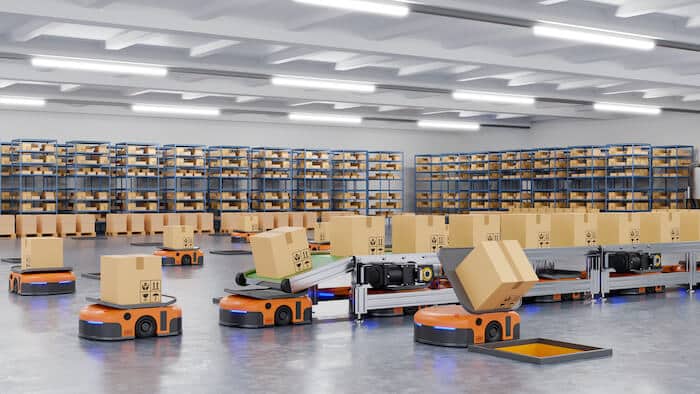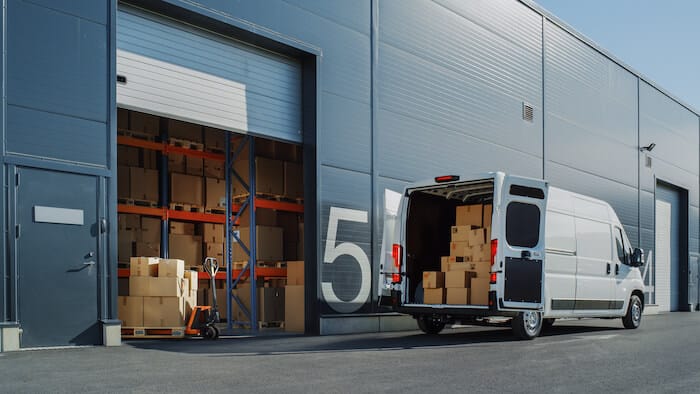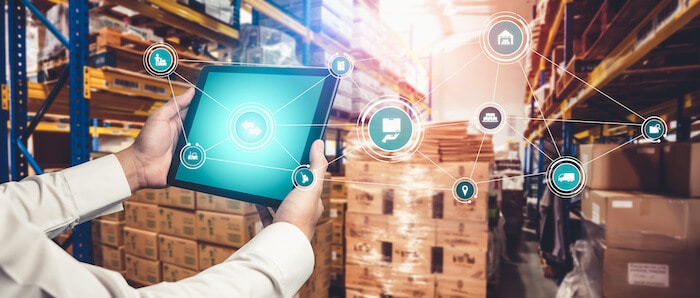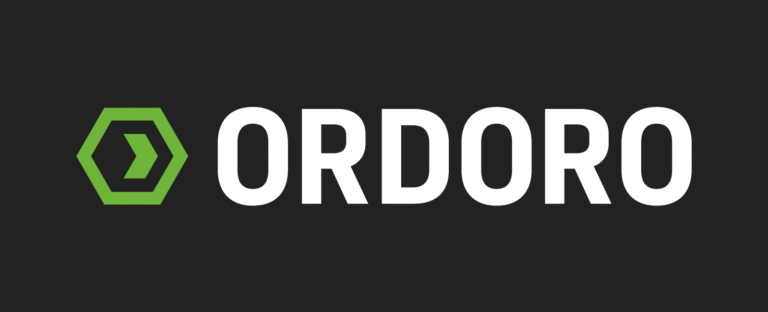When it comes to selling physical products, it’s hard to ignore Amazon as one of your channels, and maybe even the primary channel. Whether you’re selling to businesses or consumers, the pandemic changed the way everyone shopped and added to expectations for fast delivery.
This shift was so significant that in August, 2021, Amazon surpassed Walmart as the largest retailer outside of China. Amazon’s $610 billion in sales over 12 months leaped over Walmart’s $566 billion. It’s no longer a question of if you should distribute your product through Amazon — it’s a question of what role the Amazon marketplace will play in your distribution.
And once you plan to sell through the platform, you will have to decide how to fulfill your Amazon orders. You can leverage their extensive network of warehouses and take advantage of their optimized shipping system. Or, you could handle shipping products yourself. Keeping your inventory in Amazon’s facility and letting them control shipping and support is called Fulfillment by Amazon, or FBA. The do-it-yourself option is called Fulfillment by Merchant, or FBM.
There’s a big difference between both Amazon fulfillment solutions. And if you’re bringing a new product to market, you need to understand the options, including FBM’s pros and cons, and how to determine if FBM is the right fulfillment service for your product. And, that is exactly what this article is about, along with some tips for making FBM work for your products.
Before we dive into the details, we need to emphasize one important aspect of any product fulfillment solution: Your success or failure is dependent on how well you execute. Keep that in mind as we explain FBM. All of the advantages of FBM go away if you don’t execute properly.
Amazon FBA vs. FBM

No matter what Amazon’s customers order, the company quickly delivers it to their door. To make this happen, Amazon has developed digital tools and an extensive distribution network to ship products to customers. All Amazon merchants use their marketplace platform to promote their products and process customer orders. The difference starts when the order is completed, and the product needs to get to the customer.
You don’t have to use one or the other, you can mix and match. Recent data shows that 57% of Amazon merchants use FBA only, 34% use a combination, and 9% are FBM only. By offering multiple shipping options — what Amazon calls multi-channel fulfillment — they give you the flexibility to decide what is best for your own products.
Amazon FBA: Pay Amazon to Handle It
If you use Fulfilled by Amazon for any of your products, Amazon takes care of everything. All you have to do is ship sufficient inventory to their distribution centers. Once you hand fulfillment over to Amazon, you are under their control and must meet their inventory requirements. They then charge you to store what you’ve shipped to them until you sell it.
One of the best ways to understand Amazon FBA is to look at the fees. If you are an established company that sells more than 40 units per month, you are considered a professional seller. All professional sellers have to pay a monthly subscription fee for access to the system. When a product sells, you’ll also pay referral fees. These are a percentage of your revenue from each sale, based on the product’s category.
In addition, FBA sellers also pay:
- Fulfillment Fees that cover the cost of shipping, based on the size and weight of your packages.
- Storage Fees that cover the cost of storing unsold products in inventory, based on the volume your products occupy.
Note, the storage fee currently costs $0.75 per cubic foot most of the year, but it goes up to $2.40 per cubic foot from October through December. If your product is not tied to holiday sales, this could be a significant cost increase without an increased return on investment.
If you use Amazon FBA, they also handle returns and customer service. If you do not already have these capabilities, this can be a huge advantage, especially when launching a new product. Product returns go through Amazon’s website, and their customer support team handles the customer interactions.
The other aspect of Amazon FBA is automatic eligibility for two-day free Prime shipping. If you use FBM, you can still participate in the Prime program (we’ll cover what that entails), but FBA products are automatically eligible.
Amazon FBM: Own Your Post-Sale Customer Engagement

Once a transaction is complete, the Amazon system informs you that a sale has been made. Your company manages everything from that point on — this includes pulling the product, packaging it for shipping, putting the right label on it, and paying someone to ship it. You can also work with a 3rd-party fulfillment provider. If there are any problems or returns, you or your 3rd-party partner have to address them.
There are some additional options available to merchants who chose Amazon FBM.
If you’ve studied Amazon selling at all, you know that being able to offer 2-day free shipping to Prime members can be a big driver of sales. Offering Prime shipping, according to Amazon’s own material, provides three big advantages:
- You reach Amazon’s most loyal customers
- Your product will be featured more often in search
- You can offer your customers a guarantee on free, two-day shipping
As we mentioned above, this is automatically included when you use Fulfillment by Amazon. If you are doing your own fulfillment, you can still access this program and display the Amazon Prime badge on your product listing.
Amazon’s program for this is called Seller Fulfilled Prime, or SFP. It’s available to merchants who complete a trial period, agree to keep sufficient inventory on hand, ship with approved carriers, ship orders on the same day, and consistently deliver in two days to customers.
Always trying to help their merchants, and increase their slice of the revenue, Amazon will help by letting you access their shipping infrastructure and purchase your shipping through them. It’s called Buy Shipping services. It uses Amazon’s tools to find the best vendor and prints labels for you, all for a nominal fee.
Also of note, Amazon previously used the term Merchant Fulfilled Network, or MFN, to refer to sellers who handled their own fulfillment, and you may still see that term in the help center and in articles on the topic. MFN is the same as FBM.
The Pros and Cons of Amazon FBM

The Advantages of FBM
If you choose Amazon FBM, your business may benefit from these advantages:
No Fees for Using Amazon Warehouse Space
This is a big advantage if your products are large or oversized or if they sell slowly. Amazon’s FBA fees favor small, high-turnover products. If you need to store a lot of product across Amazon’s fulfillment centers, these fees can add up. And don’t forget the upcharge for long-term storage fees during the holiday season.
You Control Customer Support
This takes many forms — from handling returns yourself to being able to put additional marketing material in your packages. You can promote your customer loyalty programs or offer promotions as part of your fulfillment. Most importantly, although Amazon offers fantastic customer service, their people work for Amazon. And to them, you are just another merchant. Doing your own customer service lets you build a branded customer experience.
Brand Independently From Amazon
If an essential part of your business strategy is to build a strong, independent, product brand, you’ll want to consider FBM when selling on Amazon. When Amazon handles everything, it’s easy for your customers to associate your product with that company. You can start to control your customer experience with your Amazon product listing and buying experience, and then reinforce it with the post-sale customer experience through FBM.
Utilization of Your Existing Fulfillment Capabilities
FBA is perfect for companies just starting out that have no fulfillment capability or that only sell on Amazon. If you are adding Amazon to your distribution chain, you already have a solution. FBM allows you to use your existing brick-and-mortar and e-commerce systems with some small adjustments. With FBA, you would have to monitor and maintain two separate fulfillment systems.
Better Inventory Management
Keeping the right inventory levels has a huge impact on your cash flow. With FBA, Amazon dictates how much inventory you need and where you need it. Under FBM, you can control your inventory. Even if you use a 3rd-party service to store your inventory, you can turn it up or down as needed based on your demand and cash flow.
Increased Margins
If you run your own fulfillment properly, either in-house or with some combination of 3rd-party vendors, you should be able to do it for less than Amazon charges. They charge a premium to make things easy for their merchants, and they need to make a profit too. If you don’t need that convenience, or if your products are large or don’t sell at a high rate, then you can cut costs and increase your margins with FBM.
The Disadvantages of FBM
It’s not all upsides in the world of FBM. Here are the challenges you may face:
Cost and Distraction of Managing Returns and Customer Service
If you don’t have customer service or it’s not a strength, building that capability can take time and money. And if you outsource to a 3rd party, you lose control of the customer experience just like you would if you outsourced to Amazon. This can become particularly onerous if you are producing and selling a high-volume product. And if you do it wrong, you can damage your brand.
Difficulty Obtaining and Keeping Prime Two-Day Shipping
Amazon does offer Seller Fulfilled Prime to merchants choosing FBM. Getting SFP is not an easy task, though, because you have to prove that you can consistently deliver products in two days. If your existing fulfillment method doesn’t require two day shipping or you are building a fulfillment infrastructure from scratch, meeting the SFP requirements may be a task you need to delay.
The Time, Cost, and Focus Required to Build a World-Class Fulfillment System
Doing things on your own seems like a great way to save money — until you have to do it. So, make sure you have the resources to focus on creating a fulfillment process that’s as good or better than what Amazon offers its FBA sellers. If you can’t execute, you won’t realize the savings.
Deciding If FBM Is Right for You
For some companies, deciding if they want to be an FBA seller or an FBM seller is an easy task. It comes down to two things: What does each option cost, and can you execute your own fulfillment process?
The cost of using Fulfillment by Amazon is easy to understand because Amazon provides a tool. Their FBA Calculator will give you a good idea of what FBA will cost. To figure out the shipping cost for FBM, work with your in-house supply chain and fulfillment experts. If you are new to making a product, get quotes from 3rd-party fulfillment providers.
Add to that a good idea of how much you will sell through Amazon, your e-commerce site, brick-and-mortar stores, and other retail channels. If you need to invest in fulfillment capabilities for those other channels, using FBM makes a lot of sense.
Good market research also plays a vital role in this decision. Have a good idea of how much demand there is for your product and how much you can sell during different times of the year. Being an FBM seller makes a lot of sense if your sales are inconsistent or relatively slow. But if you think you will move a lot of product, then FBA may be right for you.
Your market research should also tell you how important product branding is to your success. Remember, you have more control over the brand experience with FBM. If you’ve designed your product correctly, you’ve built branding into every aspect of it. You don’t want to throw that away after a sale.
The importance of Prime shipping and how easily you can meet the requirements of Amazon Seller Fulfilled Prime is the final aspect to consider. Take a look at competitors who are selling on Amazon and see if they are using Prime shipping. Go back to your market research, and see how important fast and free shipping is to your potential buyers.
Build a Better Brand and Improve Margins With FBM

1. Understand Your Market and Demand
This is a fundamental part of successful product development, and it plays a critical role in fulfillment. Knowing what your customers care about — along with when they will buy and how much product they will collectively need — will help you predict your inventory and determine how it will vary throughout the year.
2. Get a Handle on All Your Costs
Before you put any systems in place, get a firm understanding of your costs at every step of the fulfillment process. This includes understanding how much 3rd-party and in-house solutions cost. And don’t forget the indirect costs of keeping inventory and putting resources into fulfillment instead of other areas of your business.
3. See How Others With Similar Products Do Fulfillment
Research and watch what others are doing. Are they using 3rd-party solutions or going in-house? Maybe you can discover what software they use for inventory management, picking, and shipping.
4. Put the Right People, Tools, and Processes in Place
As mentioned in the introduction of this article, your success as an FBM seller on Amazon will be determined by how well you execute your fulfillment strategy. And like every business strategy, the people, tools, and processes you put in place drive your success. Work with a partner like Gembah to find the right people to add to your team. Then find the right tools to manage fulfillment, and put it all together with fulfillment processes that fit your customer’s needs.
One advertising solution we recommend is Mayan, which helps Amazon sellers save time and money with optimized Amazon ad campaigns.
5. Gather and Use Data
One of the big advantages of modern digital product sales and fulfillment is the data you can capture at every step. Using that data to understand your customers, shifts in the market, and how buying trends change can be a significant competitive advantage. Use data to optimize your inventory and predict changes in your customer’s buying habits. Taking the time to gather data and use it reduces costs and improves customer satisfaction.
6. Make Fulfillment Part of Your Product Specifications
Getting your product shipped and delivered to customers is only one step in the entire product development process. Just as you should make design-for-manufacturing part of your product design, you need to also consider design-for-warehousing and design-for-shipping.
Your design drives packaging. If your product is fragile, you will have to spend more to make sure it arrives in one piece. The shape and size also determines how big of a box you need or whether you can ship it in a much less expensive padded envelope. Even if you’re not using FBA, there’s still a cost associated with shelf space, so how much room your product fills on that shelf should be a design specification.
Fulfillment by Merchant Doesn’t Mean Fulfillment by Yourself
Amazon has changed the way customers shop and how they buy. They also changed expectations on shipping. If you want your company’s products to stand out and your sales to grow, you need to develop a good e-commerce strategy, including plans for how you sell on Amazon marketplace. Once you have your Amazon business set up, you’ll need to decide how you’ll deliver on order fulfillment.
Working with a partner like Gembah and the world class resources available through our technology platform and marketplace can help you achieve your design, production, and fulfillment goals faster. Reach out today to see where we can help you on your journey. Let’s get started and see where we can go together.



